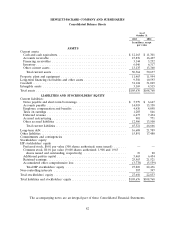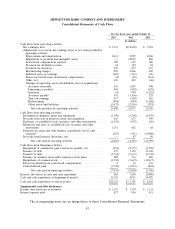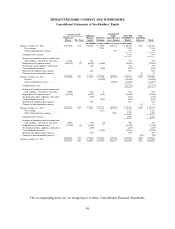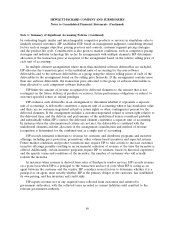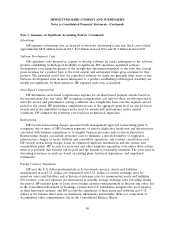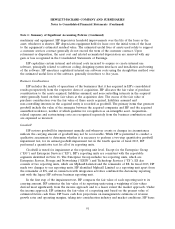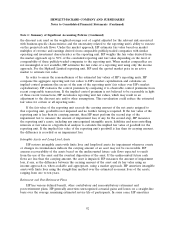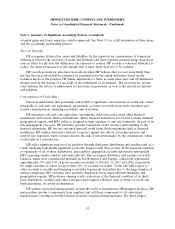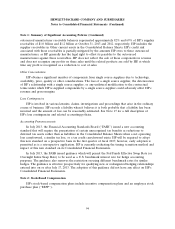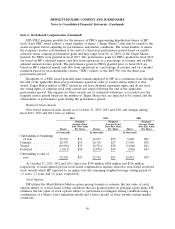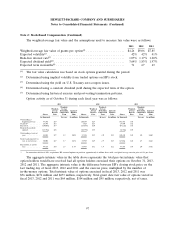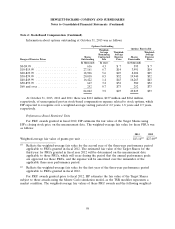HP 2013 Annual Report Download - page 98
Download and view the complete annual report
Please find page 98 of the 2013 HP annual report below. You can navigate through the pages in the report by either clicking on the pages listed below, or by using the keyword search tool below to find specific information within the annual report.HEWLETT-PACKARD COMPANY AND SUBSIDIARIES
Notes to Consolidated Financial Statements (Continued)
Note 1: Summary of Significant Accounting Policies (Continued)
Debt and Marketable Equity Securities
Debt and marketable equity securities are generally considered available-for-sale and are reported
at fair value with unrealized gains and losses, net of applicable taxes, recorded in Accumulated other
comprehensive loss in the Consolidated Balance Sheets. Realized gains and losses for available-for-sale
securities are calculated based on the specific identification method and included in Interest and other,
net in the Consolidated Statement of Earnings. HP monitors its investment portfolio for impairment on
a quarterly basis. When the carrying value of an investment in debt securities exceeds its fair value and
the decline in value is determined to be an other-than-temporary decline (i.e., when HP does not
intend to sell the debt securities and it is not more likely than not that HP will be required to sell the
debt securities prior to anticipated recovery of its amortized cost basis), HP records an impairment
charge to Interest and other, net in the amount of the credit loss and the balance, if any, to
Accumulated other comprehensive loss in the Consolidated Balance Sheets.
Allowance for Doubtful Accounts for Accounts Receivable
HP establishes an allowance for doubtful accounts for account receivables. HP records a specific
reserve for individual accounts when HP becomes aware of specific customer circumstances, such as in
the case of bankruptcy filings or a deterioration in the customer’s operating results or financial
position. If there are additional changes in circumstances related to the specific customer, HP further
adjusts estimates of the recoverability of receivables. HP maintains bad debt reserves for all other
customers based on a variety of factors, including the use of third-party credit risk models that generate
quantitative measures of default probabilities based on market factors, the financial condition of
customers, the length of time receivables are past due, trends in the weighted-average risk rating for
the portfolio, macroeconomic conditions, information derived from competitive benchmarking,
significant one-time events and historical experience. The past due or delinquency status of a receivable
is based on the contractual payment terms of the receivable.
Inventory
HP values inventory at the lower of cost or market. Cost is computed using standard cost which
approximates actual cost on a first-in, first-out basis. Adjustments to reduce the cost of inventory to its
net realizable value are made, if required, for estimated excess, obsolete or impaired balances.
Derivatives
HP uses derivative financial instruments, primarily non-speculative forwards, swaps, and options, to
hedge certain foreign currency and interest rate exposures. HP also may use other derivative
instruments not designated as hedges, such as forwards used to hedge foreign currency balance sheet
exposures. HP does not use derivative financial instruments for speculative purposes. See Note 9 for a
full description of HP’s derivative financial instrument activities and related accounting policies.
Property, Plant and Equipment
HP states property, plant and equipment at cost less accumulated depreciation. HP capitalizes
additions and improvements and expenses maintenance and repairs as incurred. Depreciation is
computed using straight-line or accelerated methods over the estimated useful lives of the assets.
Estimated useful lives are five to 40 years for buildings and improvements and three to 15 years for
90




